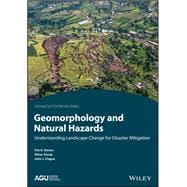Natural disasters are occasional intense events that disturb Earth's surface, but their impact can be felt long after. Hazard events such as earthquakes, volcanos, drought, and storms can trigger a catastrophic reshaping of the landscape through the erosion, transport, and deposition of different kinds of materials.
Geomorphology and Natural Hazards: Understanding Landscape Change for Disaster Mitigation is a graduate level textbook that explores the natural hazards resulting from landscape change and shows how an Earth science perspective can inform hazard mitigation and disaster impact reduction.
Volume highlights include:
- Definitions of hazards, risks, and disasters
- Impact of different natural hazards on Earth surface processes
- Geomorphologic insights for hazard assessment and risk mitigation
- Models for predicting natural hazards
- How human activities have altered 'natural' hazards
- Complementarity of geomorphology and engineering to manage threats








